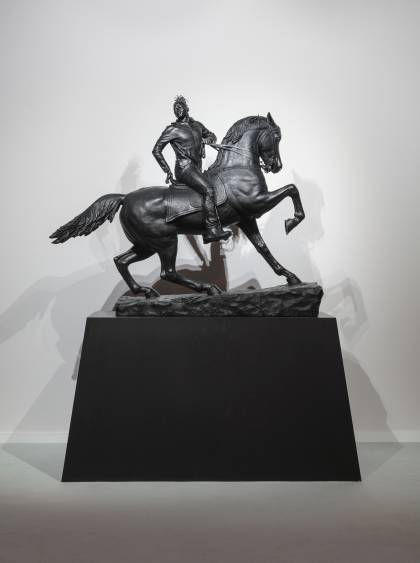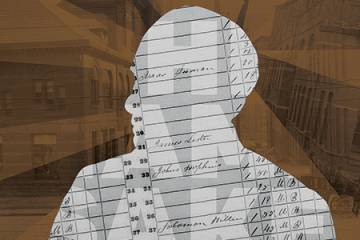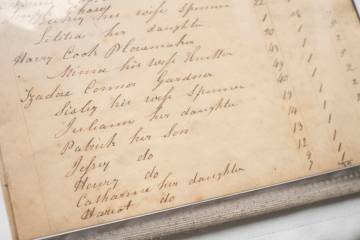When internationally celebrated artist Kehinde Wiley visited Richmond, Virginia, to open an exhibit of his works at the Virginia Museum of Fine Arts in 2016, he strolled along Monument Avenue near the museum during some downtime. And it took him to a dark place. While the handsome boulevard is leafy and lined with grand homes, along its length stood a collection of towering Confederate monuments—looming bronzes honoring the likes of Jefferson Davis, Robert E. Lee, and Stonewall Jackson.
Three years later, Wiley stood in New York's Time Square recalling that fateful day and unveiling his ambitious artistic response—a scale model of which will soon be installed at Johns Hopkins University's Homewood campus.
"I'm a Black man walking those streets, looking up at those things that give me a sense of dread and fear," he said. "What does that feel like, physically, to walk a public space and to have your state, your country, say, 'This is what we stand by?' No, we want more. We demand more. We creative people create more."
What Wiley created and unveiled was Rumors of War, a 27-foot tall bronze equestrian statue modeled closely after a Richmond statue featuring Confederate General J.E.B Stuart. While the horse is almost exactly the same, Wiley swapped the sword-brandishing Stuart in his military greatcoat for a dreadlocked Black man in a hoodie, distressed jeans, and Nikes. Wiley, who was tapped to paint President Obama's official portrait in 2018, says the sculpture, like his paintings depicting Black figures in Old Master-inspired settings, honors the "monumental in people once considered peripheral," and that the bronze depicts "the evolution of our society."

Image caption: Standing at just over 7-feet tall with its base, the sculpture to be installed at Johns Hopkins is the seventh of nine small-scale versions (plus three artist's proofs) made by artist Kehinde Wiley before he created the 27-foot tall bronze equestrian statue Rumors of War now on display in Richmond, Virginia.
Image credit: Courtesy Sean Kelly Gallery
After two months in New York, Rumors of War—the name derived from a line of biblical verse—moved to its permanent home outside the VMFA in 2020, where it is now the only horseman in the environs: Richmond's last Confederate monument was removed in 2021.
One of a select few, artist-stamped scale models of Wiley's sculpture will soon grace the atrium of JHU's Mudd Hall. The model, standing at just over 7-feet tall with its base, will be installed on Friday, April 22, and officially unveiled at 5 p.m. during an event featuring remarks and a Q+A session with Valerie Cassel Oliver, curator of modern and contemporary art at the Virginia Museum of Fine Arts. The work is on long-term loan to the university from its owner, investor, philanthropist, and JHU trustee Bill Miller.
"I think it's really important that this is happening," Johns Hopkins History of Art Professor Stephen Campbell says. "This is something myself, my students, and my colleagues will be very excited about."
He notes that it is significant that the rider in Rumors of War is not a specific person. (Indeed, the artist has stated that the face is a composite of six different Black men.) "He's standing for a people or excluded peoples in general," Campbell says, calling it a challenge to the "ideology and aesthetics of the white warrior on horseback, which became racialized by the late 19th century."
The now "habitual adornment" of our public spaces by equestrian statues has its roots in 15th-century Italy, Campbell says. Such statuary "is an expression of power and domination" with the "warrior riding into the city in triumph and glory." Confederate statues of this design are an anomaly, however, in that the Confederacy was not the victor. "They are a form of historical contestation and an aggressive way of laying claim to the historical center stage," Campbell says of the horsemen. "'We lost the war, but here I am anyway.'"
Also see
Confederate monuments began to be erected in the 1870s after "the possibility of an interracial democracy" ended and the Jim Crow era began, says Martha Jones, a professor of history and director of the Hard Histories at Hopkins project, which examines the role that racism and discrimination have played at the university. "The nation was stitched back together under the premise of white supremacy, made manifest through the veneration of Confederate generals and a political vision in which Black Americans are subordinate and excluded from the body politic," she says.
Baltimoreans erected a number of statues to Confederates or their sympathizers in this era, though the City of Baltimore, after a lengthy review process, removed the most prominent ones in 2017. Among them was a double equestrian statue of Robert E. Lee and Stonewall Jackson on the western edge of Wyman Park Dell adjacent to the Homewood campus. Only its empty granite plinth remains in an area now called Harriet Tubman Grove.
While Jones says Wiley's work was created to "speak back" to statuary in Richmond, it can play a similar role at Hopkins, having a dialogue with various historical figures, including Charles Carroll of Homewood, a slaveholder who owned the property where the Homewood campus now sits, and Keyser Quad namesake William Keyser, whose largess helped create the Homewood campus but who also espouses racist views in some of his writings.
"I think we are inviting all of Wiley's questions onto our campus," Jones says. "What does the installation of this statue require us to reflect upon when it comes to power and authority? To beauty? I think those are important questions on a campus like ours, and I hope we get an opportunity to talk about them in the presence of this important work of art."
Posted in Arts+Culture, Politics+Society











